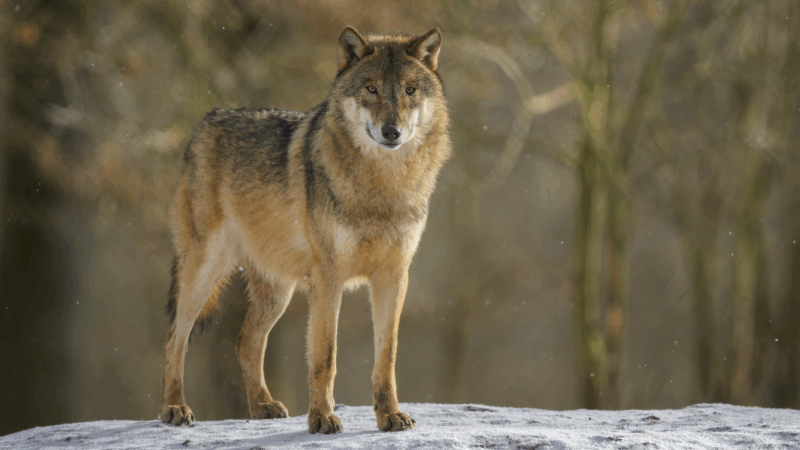New study raises questions about effectiveness of wolf hunting as a tool to help ranchers
When Montana and Idaho held their first regulated wolf hunts in 2009, one of their stated goals was to reduce pressure on ranchers. Rebounding wolf populations were killing livestock. Fewer wolves, the thinking went, should mean fewer killed cows and sheep.
The same logic is being used today in wolf management plans and is now also being discussed in Europe, which recently voted to downgrade the protected status of wolves in the European Union.
A new study though, finds that wolf hunting in the Western U.S. has had little impact on the loss of livestock. Nor has it reduced the number of times federal or state wildlife officials have been called to cull problematic wolves.
“We’ve often just fallen under this assumption that if wolves are the problem and we kill some of them, the problem isn’t as bad,” said Leandra Merz, an assistant professor at San Diego State University and one of the study’s co-authors. “It does reduce predation a little bit, but not really what we hoped for.”
The study, published in the journal Science Advances, looked at data from two states that have allowed public wolf hunts, Montana and Idaho, and two states that have not, Oregon and Washington. Researchers looked at wolf abundance, the number killed in wolf hunting and by government removals, and livestock depredation in those states from 2005 to 2001, and found that the amount of livestock saved by killing a single wolf, roughly equaled 7% of a single cow.
In other words, you’d have to kill roughly 14 wolves to save a single cow. Montana has an estimated 1,100 wolves. Idaho’s wolf population is believed to be over 1,200.
If protecting livestock is the goal, Merz said, “Based on how many wolves you’d have to kill while trying to match conservation (goals), but also allowing ranchers to continue with their livelihoods, it might not be the best solution.”
Non-lethal strategies, like adding fencing or flagging to grazing pastures, or paying people to patrol their perimeter, have long been used in many Western states. But Merz said the cost of those methods often fall on the ranchers, who are dealing with a lot of other pressures like wildfires and drought.
Merz, who’s worked in wildlife conservation and human-wildlife conflict in Africa, said she and her team don’t want the findings to be used as a political talking point in the heated debate about the ethics and merits of wolf hunting.
“This paper isn’t about whether or not we should be hunting,” she said. “We’re talking about finding a management tool that will help ranchers manage livestock predation.”
Managing human-wildlife conflict
When wolves repopulate an area naturally — or with human assistance, as was the case in Yellowstone National Park and, more recently, in Colorado — human-wildlife conflict is all but inevitable. As a result, so too is human-human conflict.
Arguments over wolf management and whether or not they deserve federal protections have been litigated endlessly, with wildlife groups arguing gray wolves haven’t fully recovered as a species and Mountain West states arguing populations have grown too high. Earlier this year a federal judge ordered the U.S. Fish and Wildlife Service to reassess threats to gray wolf populations in the Western U.S. — including hunting — after the federal agency denied a petition brought by wildlife groups to re-list the species under the Endangered Species Act.

Meanwhile, Montana and Idaho have pursued increasingly aggressive wolf-hunting quotas and methods. Montana’s Fish and Wildlife Commission will hear a proposal, Thursday, to increase the statewide quota of wolves that can be harvested from 334 to 500.
Montana Fish, Wildlife and Parks didn’t respond to a request for comment about the new study.
A spokesman for Idaho Fish and Game said the agency wouldn’t comment on the study directly because they hadn’t had time to review it in detail, “but we can say that we manage all predators with a variety of goals, which include providing hunting opportunity, keeping predators in balance with other big game (prey) species, and reducing or minimizing social conflicts, which include livestock depredations.”
In 2024, Montana hunters and trappers killed 297 wolves. Over the same period, Montana ranchers lost 62 livestock to wolf depredation, according to the U.S. Department of Agriculture Wildlife Services department. From July 1, 2023 to June 30, 2024, Idaho Wildlife Services investigated 99 wolf depredations.
When a wolf or other predator kills livestock or threatens humans, federal wildlife officials are often called to remove the animal. Often by killing it, or in some cases the pack.
The practice is controversial and expensive, so the researchers of the new study looked at whether public hunting of wolves has reduced the need for those targeted removals.
If so, an argument could be made that wolf hunts in Montana and Idaho have helped reduce government spending, said Neil Carter, associate professor at the University of Michigan School for Environment and Sustainability and senior author of the new study.
But the data didn’t bear that out.
“It didn’t matter which model we used, there was no relationship to the number of government removals of wolves in a county [to hunting] in the same year or the following year,” he said, which makes sense given that public wolf hunting doesn’t focus on a specific problem area or cattle-hungry pack of wolves.
Still, Carter said he was surprised at how small the effect of public hunting was on livestock depredations. But he said he believes the study is timely, with the conversations going on in Europe, and states like Oregon, Washington and Michigan, which may consider wolf hunts if the species gets federally delisted.
“If we’re going to tell the public that we think it’s going to help reduce livestock depredations, but it doesn’t, then we’re in a bind again because it doesn’t actually solve the problem,” he said. “And you still have this strong divisiveness around this management tool.”
A fire at a popular nightclub in India’s Goa state kills at least 25, officials say
At least 25 people, including tourists, were killed in a fire at a popular nightclub in India's Goa state, the state's chief minister said Sunday.
National parks fee-free calendar drops MLK Day, Juneteenth and adds Trump’s birthday
The Trump administration, which has railed against what it describes as "woke" policies, removed MLK Day and Juneteenth from next year's list of fare-exempt days for visitors at dozens of national parks.
Waymo will recall software after its self-driving cars passed stopped school buses
Waymo is issuing a software recall for its self-driving cars after reports the company's autonomous vehicles failed to stop for school buses.
7 deaths and hundreds of injuries are linked to faulty Abbott glucose monitors
About 3 million glucose monitoring sensors were potentially affected by a production error that caused incorrect low glucose readings.
‘The Abandons’ is a sudsy soap opera dressed up in spurs and a cowboy hat
On the surface it's a gorgeous, hardscrabble Western, awash in stark landscapes, grubby faces, bar fights and banditry. But scratch away the grime, and you expose the pure, glitzy soap opera beneath.
Sudanese paramilitary drone attack kills 50, including 33 children, doctor group says
Thursday's attack is the latest in the fighting between the paramilitary group, the Rapid Support Forces, also known as the RSF, and the Sudanese military, who have been at war for over two years.






